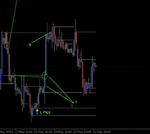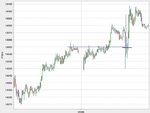firewalker99
Legendary member
- Messages
- 6,655
- Likes
- 613
fire
Anyway, a way to reduce the risk is to exit positions once specific targets are reached rather than relying wholly on judgement of the market action. For example, analysis of your successful trades will establish a reasonable average of the profit expectation of the move (not the trade) - for argument's sake let's say that comes out at 30 points.
I prefer not to rely on market action for exiting a trade. However in some cases, the market is very clearly going in one direction and not going to look back. I'm thinking of a clear breakout of an important resistance level, or when price opens with a breakaway gap. Both are high probability scenarios where price can travel significantly further than considered normal. In those cases exiting the trade on "the reasonable average of the profit expectation of the move" will most likely be too early.
If I'm right you are refering to the "maximum favourable excursion"? I haven't found much information to study about that subject. If anybody has something to add on this subject, please do. I've only come across one book that goes discussies the topic more or less in depth:
http://www.amazon.com/Maximum-Adver...3426502?ie=UTF8&s=books&qid=1180388290&sr=8-1
Barjon, I was wondering if it would be much trouble to setup a poll.
Something like this:
What is your favourite entry/exit strategy:
1) Entry with whole of your position and exiting everything at once
2) Entry with whole of your position and scaling out at fixed targets
3) Entry with whole of your position and scaling out when you feel the market is about to turn
4) Scaling in at different price levels and exiting everything at once
5) Scaling in at different price levels and scaling out at fixed targets
6) Scaling in at different price levels and scaling out when you feel the market is about to turn




